Orthodoxy is sometimes misrepresented as a religion fixated on the past, unadapted to modern science and technology. This is of course absurd. The Orthodox world today is no technological backwater. Russia in particular has long been at the forefront of exploration of the ocean, the polar regions, and outer space—and wherever Russian explorers have ventured (Soviet era excluded), so too has the Church. Thus we have an Orthodox chapel in Antarctica, priests routinely blessing spacecraft before launch, icons and relics aboard the International Space Station...
Only the United States, however, has thus far managed to land humans on the Moon, and none of the Apollo astronauts were Orthodox. There have been Bible readings and prayers on the Moon or in lunar orbit, but the Divine Liturgy, so far as we know, has never been celebrated there. Even heterodox groups with historical ties to Orthodoxy have as yet had almost no liturgical presence on the Moon, although Buzz Aldrin, a Presbyterian, received what he believed to be the Reserved Sacrament while on the lunar surface, shortly before the first moon-walk.
This liturgical absence of course may change. Barring some unexpected or apocalyptic event, there might be colonies on the Moon, Mars, and elsewhere, probably even in this century. Given the prominence of Russia as a space-faring power and the participation of other traditionally Orthodox countries in Western and private space programs, it seems nearly certain that some of the colonists will be Orthodox, and will build churches on other worlds.
Someday then, perhaps soon, there will be a Holy Moon as there is now a Holy Greece or Holy Russia: but in fact it exists already! This is true firstly on the high theological level. "The heavens declare the glory of God; and the firmament sheweth his handywork." God is everywhere, and on the most terrible day of cosmic history, when humans turned away from their crucified Creator, the Moon was "a faithful servant in black robes of mourning" [Lamentations of Holy Saturday].
The Moon is a holy place, an Orthodox place.
But not everyone knows that there are places on the moon named after Orthodox saints.
The modern system of naming lunar craters, "seas" (dark lowlands), and mountain ranges dates to 1651, when the Jesuit astronomers Giovanni Battista Riccioli and Francesco Maria Grimaldi published a detailed map of the Moon based on telescopic observation. Riccioli was responsible for naming the topographic features; perhaps surprisingly, he mostly avoided religious references. The "seas" he gave allegorical or poetic names such as "Sea of Tranquility"; the craters he named for famous astronomers. Riccioli's overall system has been maintained to this day, although explorers, aviation pioneers, and cosmonauts joined astronomers as approved eponyms for craters. Official lunar terminology is currently regulated by the International Astronomical Union (IAU), a very strict and conservative bureaucratic organization fond of secular history and ancient mythology, but with a strong bias against "living" religions, especially Christianity.[1]
Given this history, it is perhaps surprising that there are any lunar features named for Orthodox saints, but in fact there are six. Three of them are named for pre-Schism Western saints, and three for saints of the East. Although this symmetry was not intended by the selenographers, it may perhaps be considered providential.
 Sea of Nectar. Photo: Wikemedia.
Sea of Nectar. Photo: Wikemedia.
Three of the six saintly craters (and one other with a name of Orthodox interest) are situated along the edges of the Sea of Nectar, which might be called the "lunar Holy Land" for this reason. The Mare Nectaris is a round, lava-filled basin, roughly the size of Lake Superior. It is easily visible to the naked eye as one of the smaller dark spots on the full moon. The four Sea of Nectar craters we will discuss were all named by Riccioli himself in his original list of lunar toponyms.
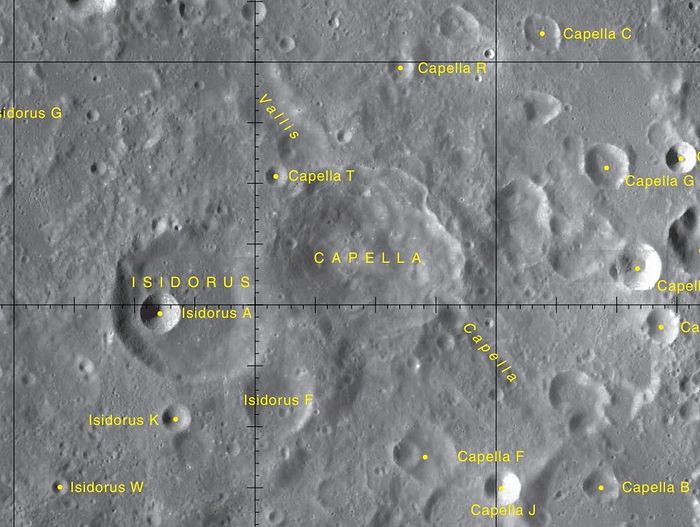 Map of northern Mare Nectaris, showing Isidorus crater. Wikipedia.
Map of northern Mare Nectaris, showing Isidorus crater. Wikipedia.
On the sea's northern "coast" Riccioli noted a circular crater which he named Sanctus Isidorus.[2]
St. Isidore of Seville (6th/7th Centuries; feast day April 4) was the author of a famous encyclopedia, the Etymologiae; it was a synopsis of everything an educated person in Late Antiquity was expected to know (including mathematics and astronomy in Book III, and physics in Book XII). When barbarian invasions and political chaos nearly destroyed classical civilization in the Latin West (a process already well underway in St. Isidore's lifetime), copies of the Etymologiae could still be found in many monasteries, a cultural lifeline to the Roman past. Isidore's name is on the Moon because generations of Latin astronomers learned the basics of science from his book. His name is on the calendar of saints for a different reason: together with his brothers Sts. Leander and Fulgentius and his sister St. Florentina, he was largely responsible for the conversion of the Visigoths from Arianism to Orthodoxy. His memory lived on in Spain for centuries; even the Muslim Moors seem to have venerated him.
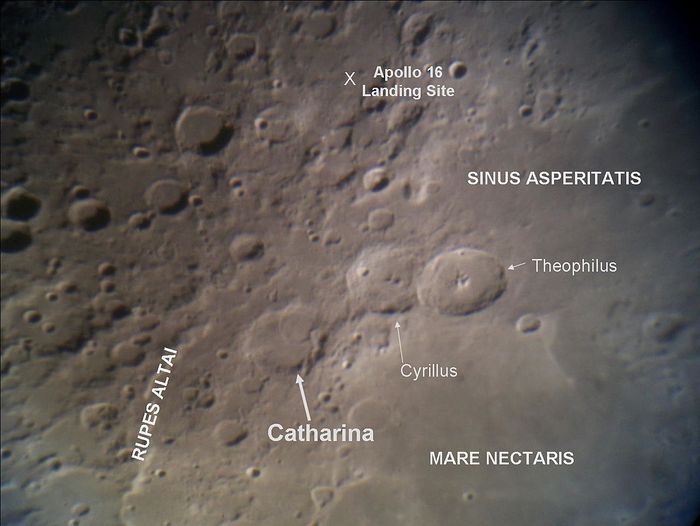 Catherina crater. Photo: EricandHolli, Wikipedia.
Catherina crater. Photo: EricandHolli, Wikipedia.
On the western "coast" of the Sea of Nectar are three large craters, much more conspicuous than Isidorus. These are the "Three Alexandrians": from south to north Catharina, Cyrillus, and Theophilus.
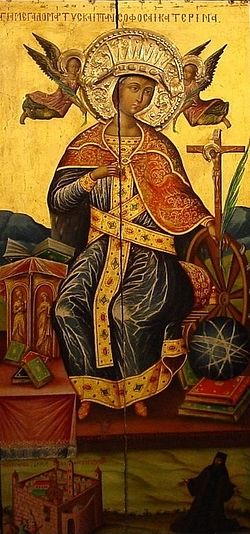 St. Catherine with armillary sphere. Photo: SaintCatherineLubbock.org. Catharina is named for the great-martyr Catherine of Alexandria. The lives of St. Catherine always stress her great secular learning, especially in the natural sciences. Full-length icons of her frequently show a small round object on the ground at her feet (not the broken torture wheel). This is an armillary sphere, a sort of portable planetarium used by ancient astronomers to model the motion of the planets.
St. Catherine with armillary sphere. Photo: SaintCatherineLubbock.org. Catharina is named for the great-martyr Catherine of Alexandria. The lives of St. Catherine always stress her great secular learning, especially in the natural sciences. Full-length icons of her frequently show a small round object on the ground at her feet (not the broken torture wheel). This is an armillary sphere, a sort of portable planetarium used by ancient astronomers to model the motion of the planets.
Cyrillus is St. Cyril of Alexandria, the great enemy of Nestorianism and one of the most important Church Fathers; Theophilus is his uncle and predecessor on the Episcopal Throne.
Because of Alexandria's reputation as a scientific center, the Council of Nicaea had entrusted the Alexandrian church with the task of calculating the date of Pascha—not a trivial problem, especially in an age without advanced optics, electronic calculators, or even Arabic numerals. Initially the computation may have been done one or two years at a time: the annual paschal letters of the Alexandrian bishops, to the extent that they have survived, are important patristic documents. Theophilus, well before his consecration to the episcopate, undertook the major technical project of calculating the date in advance for the 99 years 380 to 479. St. Cyril later extended this table to 531, and wrote a defense of the computational methods used. Because of this tour de force of applied astronomy, Riccioli placed both men's names on the Moon.
Of course many people associate St. Cyril with astronomy in a different and less fortunate context: the great pagan astronomer Hypatia (also commemorated by a lunar crater) was brutally murdered by a mob of political radicals who claimed to be Orthodox and followers of Cyril. Although it is true that Cyril and Hypatia were very public political and ideological opponents, the historical evidence indicates that Cyril almost certainly had no culpability for the crime. This has not stopped enemies of Christianity (starting in the 5th Century) from using the tragedy to tarnish Cyril's reputation, as well as the Church's. It is interesting that these critics, in modern times often depicting Hypatia as a “martyr for science”, rarely mention that St. Cyril himself was an astronomer.
His uncle Theophilus, although an important figure in Church history, is not considered an Orthodox saint, and indeed is a controversial figure because of his bitter hostility to St. John Chrysostom, and his violence against political opponents: he, far more than Cyril, set in motion the chain of events eventually leading to the death of Hypatia.[3]
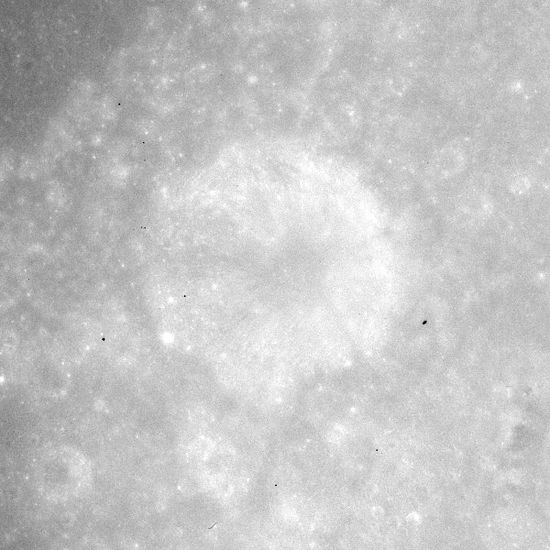 Apollo XV photograph of Boethius. Wikipedia.
Apollo XV photograph of Boethius. Wikipedia.
The craters by the Sea of Nectar were among the first places on the Moon to be named. Astonishingly, a crater elsewhere was named for a Western saint as recently as 1976. This is the tiny crater whose eponym is St. Severinus Boethius (feast day October 23). Boethius was a 6th Century intellectual and civil servant who worked for the Ostrogothic King Theodoric, helping to keep the Roman government bureaucracy functional despite the fall of Rome. He was executed on the king's orders in 524, accused of plotting with agents of Constantinople to overthrow the Goths and restore the Roman Empire. Because such a plot, if it existed, had religious overtones—the Goths were Arians—Boethius was considered a martyr, although the reasons for his fall were mainly political.
St. Boethius devoted much of his attention to translating the works of Aristotle and the Greek mathematicians into Latin, as well as writing original works on arithmetic and music theory; these scientific activities are presumably why the IAU approved him as the eponym of the crater. Doubtless it was helpful that many modern writers have depicted Boethius as "the last ancient philosopher" and (ignoring his authorship of tracts on the Trinity and against Nestorianism and Monophysitism) suggested that he was a "secret pagan". The reason for this attitude is that St. Boethius's last and greatest work ("The Consolation of Philosophy", written while he was in prison awaiting execution) makes no direct reference to Christ. However, the book is clearly modeled on Old Testament wisdom literature, and its Platonist/Stoic ethos is very much that of the Apologists. For a thousand years no-one seems to have doubted that the “Consolatio” was a Christian work; it appears to have been admired by the Emperor Justinian, and the pious King Alfred the Great personally translated it into English.[4]
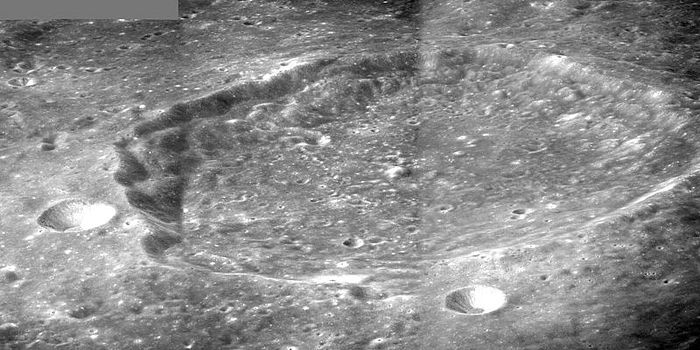 Ansgarius crater. Mosaic of three Apollo 8 images, by James Stuby. Wikipedia.
Ansgarius crater. Mosaic of three Apollo 8 images, by James Stuby. Wikipedia.
The crater Ansgarius is near the eastern limb (rim) of the Moon as seen from the Earth. It is named after St. Ansgar, better known in English as St. Oscar, the enlightener of Scandinavia (9th Century; feast day February 3). St. Ansgar was specifically mentioned in the famous 1952 report of St. John the Wonderworker to the ROCOR Synod defending the veneration of pre-Schism Western saints; anyone who rejects the sanctity of Ansgar, according to St. John, should also reject that of Cyril and Methodius. St. Ansgar has no connection to astronomy, but his missionary journeys were apparently seen by some 19th century Germans as the "discovery" of Scandinavia, in the same way that the voyages of Columbus were seen as the discovery of America. The crater was named in the 1830s by Johann Heinrich von Maedler, who named a number of lunar features after famous explorers.[5]
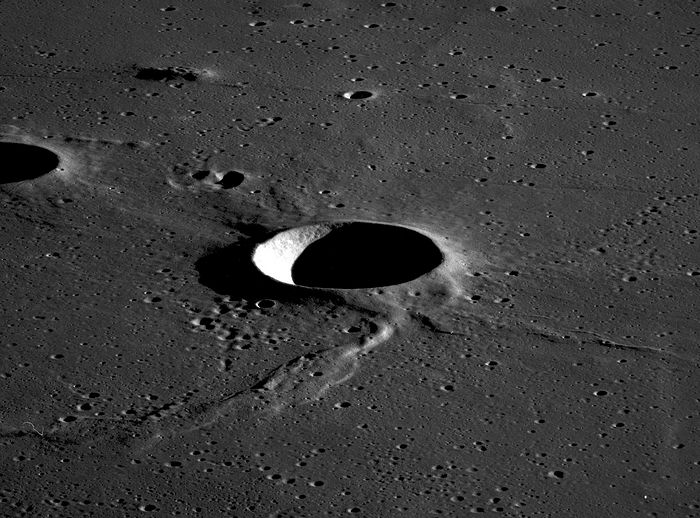 Sinas Crater. James Stuby, Wikimedia.
Sinas Crater. James Stuby, Wikimedia.
Before discussing the last crater named for a saint, it is perhaps worth mentioning that there are many other lunar features named for Orthodox people. For example, not far from the Apollo XI landing site in the Sea of Tranquility is a crater called Sinas; it is named for George Sinas and his son Simon, famous 19th century financiers who endowed the National Observatory of Athens and other scientific projects. They were Greeks, and the philanthropy of Simon Sinas extended to building the Annunciation Cathedral in Athens and the beautiful Greek Orthodox church in Vienna. A crater in the Mare Imbrium is named for the great Serbian engineer Michael Pupin, whose devotion to Orthodoxy extended to writing a book about the Serbian Orthodox Church and its history. The crater Milankovitch near the Moon's North Pole is named for another Serb, the astronomer Milutin Milankovic—a somewhat controversial figure in Orthodoxy, since the "Revised Julian" or New Calendar adopted by many local churches in the 1920s is partly his creation. Sikorsky bears the name of the pioneer of the helicopter, who used his fortune to support Orthodox churches in the United States, and who wrote a number of theological essays.[6]
The crater Lomonosov is of course named for the "Leonardo da Vinci of Russia", who remained famously Christian in the midst of the 18th Century Enlightenment. Many craters are named for 19th century Russian scientists who were at least nominally Orthodox. Others (especially on the far side, which was largely mapped by the Soviets) bear the names of cosmonauts and space scientists of the USSR, a few of whom, although officially communists, were either secretly Christians or converted later. (An obvious example is the crater Tereshkova.) Whether any of these people are saints is known only to God.
The crater Dionysius, however, is unquestionably named for a saint. Riccioli himself marked it on his chart as "Sanctus Dionysius Areopagita". At first glance, the Areopagite does not seem like an obvious candidate for lunar eponymy. There are other saints one might have expected instead: Dionysius Exiguus, for example, who produced the next extension of St. Cyril's paschal tables, or the Venerable Bede, foremost astronomer of his time. Since Riccioli was a Jesuit, one might have expected him to choose a post-Schism scientist, probably Albertus Magnus or Thomas Aquinas. But upon closer examination, the choice is a very good one, and quite deep.
In his Eleventh Letter, St. Dionysius reminds his opponent Apollophanes how, as students travelling in Egypt, they had once been startled to observe a solar eclipse, after which, "taking the table of Philip Aridaeus, and contemplating the orbs of heaven, we learned ... that an eclipse could not, at that time, occur." It was, of course, the moment of the death of God upon the Cross.[7] And in "The Divine Names" (III, ii), St. Dionysius tells us of another kind of eclipse: the "depositing of the Life-springing and God-receptive body".
Which brings us to the seventh saint on the moon, or rather to the "saint greater than all the saints", the Most Holy Theotokos: "And there appeared a great wonder in heaven; a woman clothed with the sun, and the moon under her feet, and upon her head a crown of twelve stars." There is no crater named for her,[8] but she stands upon the Moon, and it is her, and her Son, of whom we should think when we behold the Moon in the sky (or, perhaps someday, beneath our own feet).
May we all be saved through the prayers of Saints Isidore, Catherine, Cyril, Boethius, Ansgar, and Dionysius, and the intercessions of the Most Holy Theotokos.

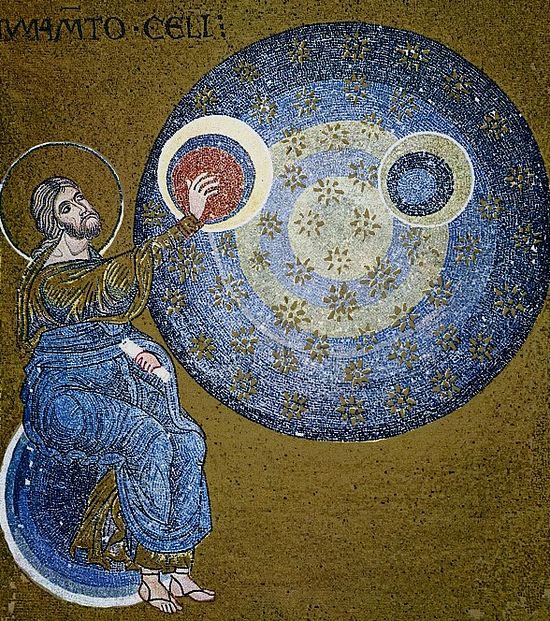
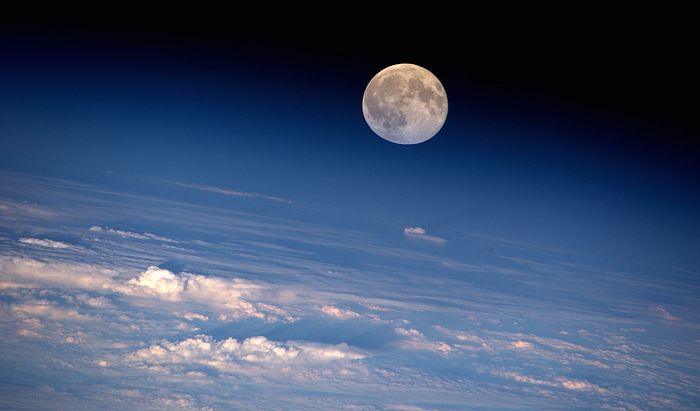
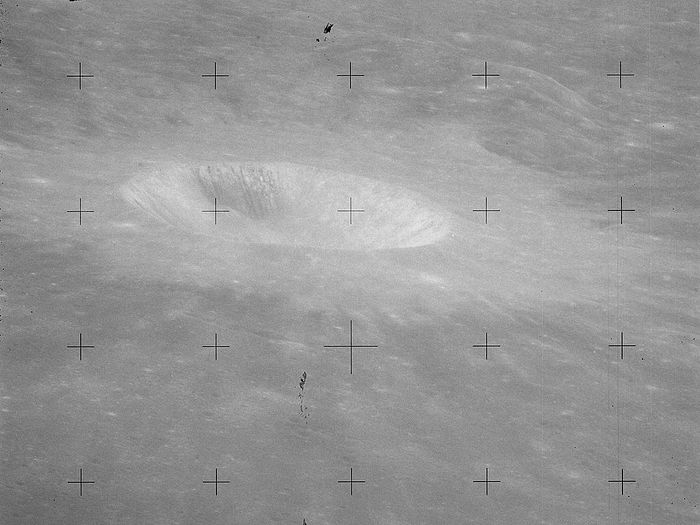
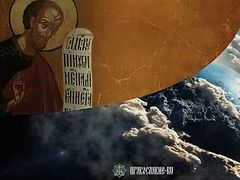
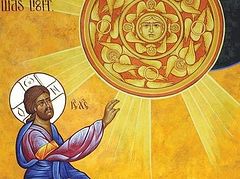
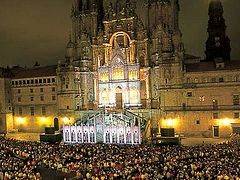
1) Saint Theophylacht of Ochrid: Heavenly bodies do not cause evil (See www.orthodoxwitness.org/words/heavenly-bodies-do-not-cause-evil)
2) Saint John of Karpathos (Philokalia, vol. 1): The condition of man (See www.orthodoxwitness.org/words/the-condition-of-man)